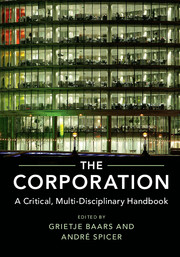Book contents
- Frontmatter
- Contents
- List of Contributors
- Acknowledgements
- Introduction: Why the Corporation?
- PART I DISCIPLINARY OVERVIEWS
- PART II INTERDISCIPLINARY THEMATIC CHAPTERS
- 1 The Evolution of the Corporate Form
- 2 The Multinational Corporate Group
- a The Multinational as a Corporate Form: A Critical Contribution from Organization Studies
- b Embedding the Multinational Corporation in Transnational Sustainability Governance
- c Banks as Global Corporations: From Entities to ‘Ecological Habitats’
- 3 The Financialization of the Corporation
- 4 Corporate Value Chains
- 5 Corporate Citizenship
- 6 The Corporation and Crime
- 7 The Corporation and Ideology
- 8 Corporation and Communities
- 9 Corporations and Resistance
- 10 Alternatives to the Corporation
- Index
- References
c - Banks as Global Corporations: From Entities to ‘Ecological Habitats’
from 2 - The Multinational Corporate Group
Published online by Cambridge University Press: 31 March 2017
- Frontmatter
- Contents
- List of Contributors
- Acknowledgements
- Introduction: Why the Corporation?
- PART I DISCIPLINARY OVERVIEWS
- PART II INTERDISCIPLINARY THEMATIC CHAPTERS
- 1 The Evolution of the Corporate Form
- 2 The Multinational Corporate Group
- a The Multinational as a Corporate Form: A Critical Contribution from Organization Studies
- b Embedding the Multinational Corporation in Transnational Sustainability Governance
- c Banks as Global Corporations: From Entities to ‘Ecological Habitats’
- 3 The Financialization of the Corporation
- 4 Corporate Value Chains
- 5 Corporate Citizenship
- 6 The Corporation and Crime
- 7 The Corporation and Ideology
- 8 Corporation and Communities
- 9 Corporations and Resistance
- 10 Alternatives to the Corporation
- Index
- References
Summary
Introduction
The aim of this chapter is to offer a conceptualization of banks as global corporations. The major challenge in such a task is to see beyond the silos of the main academic disciplines that traditionally examine banks and banking and to recognize that, organizationally and functionally, modern banking operates under complex governance structures. These involve national and international regulations and norms, private industry standards (such as accounting and reporting standards), rules of compliance, registration, licensing and insurance provisions. Today, a typical multinational enterprise, banks included, consists of legally independent corporate entities, each licensed to operate within a specified territorial realm, that are linked to each other's legal entities in other countries (or even their own) through economic connections. This organizational and governance complexity is not easily accommodated within traditional academic approaches to finance and banking.
There appears to be a lack of a specialized academic tradition of analysing banks and other financial institutions and distinct entities. In economics, for instance, any enterprise – financial and non-financial – is typically understood as a firm, defined as an entity that ‘uses inputs to make output’ (Sloman et al., 2013: 4), a notion that abstracts away from legal, institutional, political and cultural specificities of modern economies. In political science – a discipline that enquires into the origins of power and influence – banks too, tend to be equated with other non-financial businesses and are examined on the basis of their political power and influence over decision making (Pagliari, 2015; Pagliari and Young, 2015). Legal scholars describe the phenomenon of the corporation broadly, focusing on the underlying property relations and debating the nature and the personality of the corporation. The latter, in turn, can be understood as either an agglomeration of individuals and hence a natural result of private initiative; or as an artificial creation of state law that has a separate existence from its shareholders and management (Millon, 1990: 201). None of these divergent disciplinary approaches to banking recognizes the specific features of banking, as a unique business enterprise, which endow financial institutions with unprecedented structural power in our societies. Yet, partly as a reflection of such specificities, the corporate character of global banks proves extremely difficult to pin down.
- Type
- Chapter
- Information
- The CorporationA Critical, Multi-Disciplinary Handbook, pp. 268 - 279Publisher: Cambridge University PressPrint publication year: 2017



